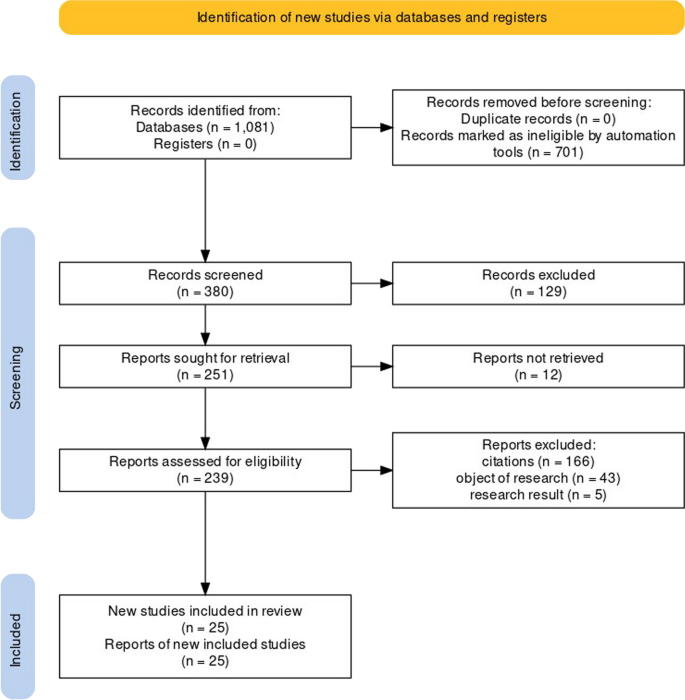
The adoption of information and communication technology (ICT) in small- and medium-sized firms (SMEs) is steadily increasing. However, the implementation of ICT in SMEs is hindered by constraints, such as limited financial resources, lack of ICT knowledge, and reluctance to change. The objective of this study is to identify and analyze prevalent patterns, obstacles and influences that impact the adoption of ICT in SMEs in developing nations. In addition, this study aims to provide recommendations on the most effective methods to optimize the utilization of ICT in these contexts. This review is conducted using a sample of 25 publications that have been published and are available in the Scopus database. The selection process focuses on works that have received significant citations and have been published between 2014 and 2023. The PRISMA statement form was utilized to elucidate the comprehensive procedure of selecting and accepting pertinent publications. This research makes two distinct contributions. The writers begin by doing a thorough literature analysis to examine the progress of ICT in the past decade. They next emphasize noteworthy research discoveries in this field. Furthermore, the authors give a comprehensive analysis of the ICT literature by quantifying yearly publications and identifying SMEs that primarily utilize ICT, academic journals that publish pertinent articles, and ICT-related publications across various fields and areas in developing nations. The study also discloses the papers, journals, and authors that have received the highest number of citations. The author's final argument in the paper is that, despite the extensive research conducted in the field of ICT, there is a necessity to customize strategies and policies that can support SMEs in the ICT sector, particularly in developing countries.
Previous studies on Information and Communication Technology have primarily focused on large and multinational firms (Barua et al., 2004; Bharadwaj, 2000; Brynjolfsson & Hitt, 2020; Liang et al., 2007; Mithas et al., 2011) compared to SMEs (Chen et al., 2002; Cragg & King, 1993). Currently, the attention has turned towards small- and medium-sized enterprises (SMEs) as indicated by the works of (Arendt, 2008; Chege et al., 2020; Marcelino-Sádaba et al., 2014; Müller et al., 2018; Wielicki & Arendt, 2010). The development of skills and attitudes, including the ability of SMEs to recognize and respond to value-creation opportunities, is critical for SMEs to leverage technology better (Cunningham et al., 2023). Nevertheless, the existing body of evidence regarding the factors that promote or impede the adoption of information and communication technology by small and medium enterprises (SMEs), particularly in developing nations, remains scarce (Kurnia et al., 2015).
Empirical studies that mention how to implement information and communication technology in SMEs in developing countries are still few (Kurnia et al., 2015; Mapeshoane & Pather, 2016). Prior systematic reviews and bibliometric analyses predominantly utilized data sourced from the Web of Science (Dabi et al., 2020; D'Angelo & Belvedere, 2023; Tubis & Grzybowska, 2022; Yogarajan et al., 2023). This research is distinctive, because it utilizes data from the Scopus database, which is recognized as the largest peer-reviewed literature database encompassing a broad spectrum of global and regional journals, conference proceedings, and books (Baas et al., 2020; Cordes & Marinova, 2023). It is argued that SMEs in developing countries face various technical capability constraints when applying information and communication technology (ICT) for business growth and competitiveness. SMEs in developing countries exhibit less enthusiasm for implementing ICT compared to large companies due to financial limitations and organizational and managerial preparedness (Shahadat et al., 2023). Therefore, it is necessary to examine the factors contributing to the disparity in the adoption of ICT practices in small firms, specifically in SMEs of developing countries. Hence, the objective of this study is to examine the existing literature on information and communication technology (ICT) in small- and medium-sized enterprises (SMEs) and analyze the patterns and themes in ICT research by addressing the following research inquiries.
RQ 1. How has ICT evolved over the years?
RQ 2. What are the main research streams and focus areas in the ICT literature?
RQ 3. What internal and external factors influence ICT adoption in SMEs of developing countries?
RQ 4. What are the barriers and outcomes of ICT implementation in developing country SMEs?
SMEs in developing countries play a crucial role in economic development, employment, and innovation. The precise parameters that define small- and medium-sized enterprises (SMEs), such as the number of employees, yearly turnover, and investment amount, can vary considerably across different countries. The various interpretations of this concept highlight the tailored strategies implemented by nations to assist small- and medium-sized enterprises (SMEs) based on their distinct economic environments and governmental goals. In India, small and medium enterprises (SMEs) are classified according to their capital expenditure on equipment and machinery. Micro-enterprises are businesses with a capital investment of up to INR 2.5 million (Kumar et al., 2017). In Bangladesh, SMEs are classified as firms with fewer than 100 employees (Azam, 2015). In Malaysia, small- and medium-sized enterprises (SMEs) are classified according to their staff count and yearly revenue. Small firms typically have a workforce of 5 to 75 individuals and generate annual revenues ranging from RM300,000 to RM5 million. On the other hand, medium enterprises employ 75–200 people and have an annual turnover between RM5 million and RM50 million (Ibrahim et al., 2018).
Small- and medium-sized enterprises (SMEs) are crucial for the economic progress of emerging nations, making substantial contributions to the gross domestic product (GDP), employment rates, and exports. SMEs in Bangladesh contribute approximately 45% of the manufacturing value added, almost 80% of industrial employment, and between 75% and 80% of export earnings. In addition, the agricultural industry contributes approximately 44% of employment in the country, highlighting its significant importance in job generation and economic growth. SMEs in Bangladesh are estimated to account for approximately 20–25% of the country's GDP (Azam, 2015). On a global scale, small- and medium-sized enterprises (SMEs) are acknowledged for their significant role in fostering economic growth and generating employment opportunities. SMEs in Singapore account for 46% of the country's GDP and 63% of its employment. In European countries, small- and medium-sized enterprises (SMEs) contribute approximately 60 to 70% of the total employment. In Japan, this percentage is much higher, surpassing 78%. SMEs in Pakistan make up around 40% of the annual GDP, 25% of industrial exports, and 78% of individual employment (Pathan et al., 2017). These contributions demonstrate the crucial significance of SMEs in stimulating economic expansion, enhancing job prospects, and elevating living standards, thereby establishing them as the fundamental pillar of the economy (Heim et al., 2019).
Information and communication technology (ICT) refers to various technologies that collect, manipulate, retain, and distribute information. It encompasses technologies such as the internet, telecommunications (mobile phones and landlines), wireless networks, digital broadcasting, and other digital technologies that transmit and manipulate information in different formats. Information and communication technology (ICT) is fundamental to contemporary existence. It has become an essential element of company operations, facilitating organizations to function more efficiently, expand into new markets, and enhance communication and information exchange (Kossaï & Piget, 2014).
Regarding small- and medium-sized enterprises (SMEs), it is essential to consider the significance of information and communication technology (ICT). It provides exceptional prospects for firms to raise operational efficiency, elevate customer service, and foster product and service delivery innovation. The adoption and utilization of ICT by SMEs play a crucial role in enhancing their performance and competitiveness, particularly in a globalized economy, where market success is often contingent upon technological competence (Azam, 2015). Information and communication technology (ICT) allows small- and medium-sized enterprises (SMEs) to optimize their operations, decrease expenses, and enhance their ability to adapt to market fluctuations. In addition, it empowers them to engage in competition at a broader scope, accessing untapped markets and clientele via e-commerce and online advertising.
The utilization of information and communication technology (ICT) in small and medium enterprises (SMEs) is of utmost importance for advancing the economy in emerging nations. A study conducted on Tunisian SMEs in the electrical and electronics industry has demonstrated that effectively implementing ICT can substantially impact firm profitability. The study found a favorable correlation between the extent of ICT utilization and firm performance (Kossaï & Piget, 2014). Moreover, implementing information and communication technology (ICT) in small and medium enterprises (SMEs) can foster creativity, stimulate expansion, and empower small enterprises to compete with greater efficiency on both domestic and global scales. Nevertheless, despite the potential advantages, small- and medium-sized enterprises (SMEs) require assistance in embracing information and communication technology (ICT), which involves overcoming internal and external obstacles. It is crucial to tackle these difficulties to fully use the advantages of ICT for small- and medium-sized enterprises (SMEs), enhance their role in economic development, and guarantee their long-term growth and competitiveness in the global market (Vidhyalakshmi & Kumar, 2016).
Small- and medium-sized enterprises (SMEs) require assistance in embracing information and communication technology (ICT) due to the rapid digitalization prompted by the COVID-19 pandemic. This shift has exacerbated the disparity between large and small firms. However, large corporations have successfully utilized omnichannel strategies and captured a substantial share of consumer demand during limited social mobility. On average, small- and medium-sized enterprises (SMEs) have yet to tap into internet commerce's complete benefits fully. This disparity highlights a digital economy dichotomy wherein tiny enterprises face challenges in competing with their larger counterparts in the digital realm. Furthermore, the intrinsic constraints of small- and medium-sized enterprises (SMEs), such as their incapacity to benefit from economies of scale and to innovate with cutting-edge technologies, worsen their challenges in adopting information and communication technology (ICT). These constraints impede their ability to compete globally and restrict them to catering to domestic consumers (Meramveliotakis & Manioudis, 2021).
The primary aim of this study is to investigate the influence of information and communication technology on small- and medium-sized firms (SMEs) in developing nations (Paprotny, 2021). This study has undertaken a systematic literature review (SLR) of prior research on information and communication technology (ICT) in small- and medium-sized enterprises (SMEs). A systematic literature review (SLR) seeks to resolve concerns in the current body of research by finding, critically assessing, and incorporating all pertinent studies conducted within a specific topic while also addressing one or more specific studies. Systematic literature review (SLR) distinguishes itself from typical literature reviews by placing a strong emphasis on transparency, evidence, impact, validity, and causality.
This approach ensures the robustness of the evidence gathered (Mohamed Shaffril et al., 2021). The PRISMA statement form is utilized to delineate the comprehensive procedure of selecting and excluding pertinent papers in systematic reviews and meta-analyses. The PRISMA statements aid researchers in enhancing the documentation of systematic literature review publications (Page et al., 2021). The review was conducted using research publications published in the SCOPUS database from 2014 to 2023 as the basis.
Literature search. A search for relevant publications was conducted on February 26, 2024, using the Scopus database. The search was performed using the search terms "ICT*" and "SME*." The search produced a total of 1081 articles from 2014 to 2023, covering 10 years. Given the significant increase in publications over the past decade, we have chosen this time to perform a systematic review on the implementation of information and communication technology (ICT) in small and medium enterprises (SMEs), despite its initial introduction in 1999 by Premkumar and Roberts. Following the curation of papers published between 2014 and 2023 in the domain of business and management, a total of 380 articles were retained. Given the focus of our research on business and management, we have disregarded articles that were published in other subject areas. There were 251 documents left after choosing the document type "Articles." Upon choosing the publication stage and picking articles written in the "English" language, a total of 239 articles were extracted. To enhance the reliability of the analysis while upholding quality criteria, this study specifically chose articles that had 20 or more citations. Subsequently, a total of 73 papers were selected for the study based on their citation count of 20 or above. After eliminating unnecessary papers, the total number of surviving papers was 25. Figure 1 provides a concise overview of the process of including and excluding certain elements.

Quality assessment The selected papers underwent a thorough and rigorous screening procedure to incorporate the most outstanding research in the study. Only papers with a high number of citations (more than 20) were chosen to uphold standards of research quality and enhance comprehension of topics. Paper duplication was rigorously managed during the selection process.
Criteria for eligibility and inclusion This review paper is derived from the original published article. The study eliminated conference papers to uphold quality requirements. The researchers focused exclusively on examining ICT business and management viewpoints, excluding all other sectors from their study. The database Scopus was selected for article search because of its extensive collection of publications in the discipline, surpassing other databases such as Web of Science (Cordes & Marinova, 2023). Due to the predominance of English in the field of ICT literature, only articles written in English were chosen. An additional rationale for exclusively choosing papers written in English is its global comprehensibility and widespread acceptance. This study included both articles that are freely accessible to the public (open-access) and papers that have limited access (restricted access).
The study used a qualitative synthesis For this study, a total of 25 publications published in Scopus-indexed journals between 2014 and 2023 were chosen for examination. Following the selection of the papers, the procedure proceeded with two consecutive steps. The initial phase involved exporting relevant metadata from Scopus to Microsoft Excel to facilitate a descriptive study of the literature. This analysis focused on the distribution of publications by year and field and the application of ICT in developing nations to enhance competitiveness in SMEs.
An analysis was undertaken to observe the number of publications and publication trends during the past decade, focusing on a year-by-year basis. A sector study was undertaken to identify industries within small- and medium-sized enterprises (SMEs) that are adopting information and communication technology (ICT). This systematic review also highlighted the internal and external elements of ICT adoption that can enhance the competitiveness of SMEs. These factors are illustrated in Fig. 2.
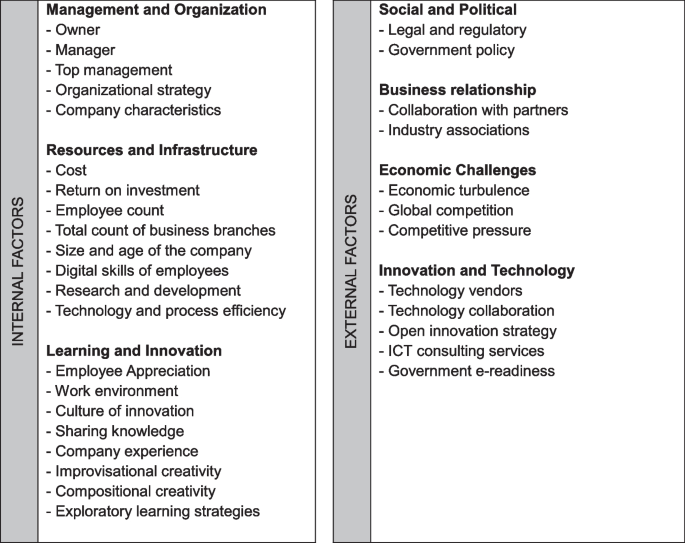
In the growing area of information and communication technology (ICT) in small and medium enterprises (SMEs) in developing nations, it is crucial to identify and address internal and external obstacles to achieve sustainable growth and maintain competitiveness. Based on a thorough analysis of 25 studies, a valuable analytical framework has evolved to guide future research efforts.
The framework illuminates the intricate interrelationships among different obstacles and offers strategic avenues for successful resolution. As researchers delve into further investigations in the field of ICT in SMEs in developing countries, this fundamental framework acts as a guide, enabling a more profound comprehension of the obstacles and possibilities, ultimately leading to transformative advancements in theory and practice. Figure 3 provides additional information on the analytical framework.
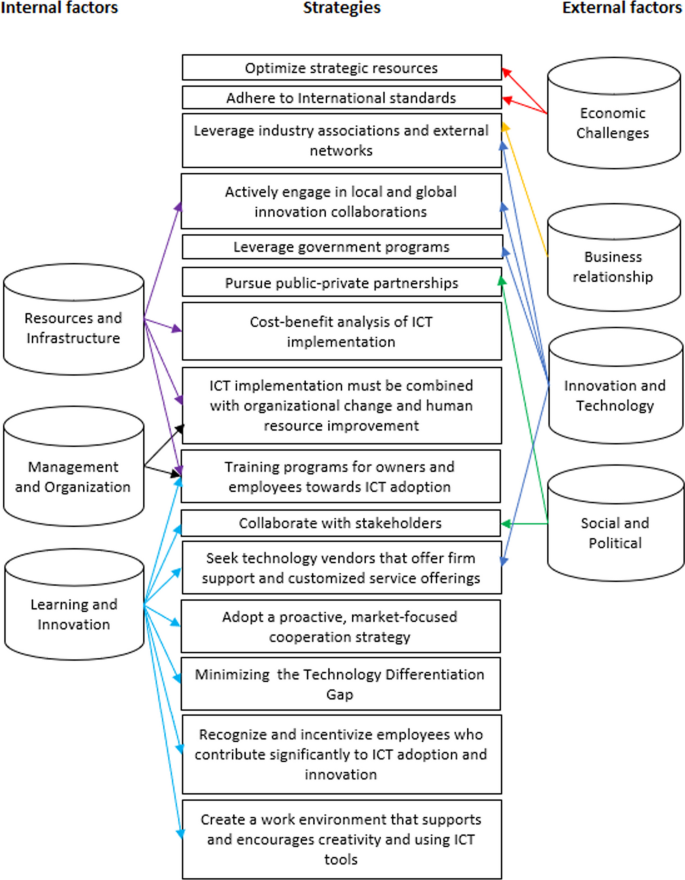
It is crucial to consider the prevailing theoretical and methodological approaches researchers employ to assess the progress of research on the utilization of information and communication technology in small- and medium-sized enterprises (SMEs). Of the 25 examined publications, only 18 explicitly referred to a theoretical framework, while the remaining articles discussed notions based on previous research. The subsequent passage delineates the theoretical frameworks employed in the study conducted thus far.
IT does not matter questions the conventional belief that technological innovation is the main factor for gaining a competitive edge. Instead, it promotes prioritizing resource optimization and strategic organizational value. According to this idea, small- and medium-sized enterprises (SMEs) should shift their approach from making significant investments in Information Technology infrastructure to maximizing the use of their current resources and adopting information and communication technology (ICT) services that fulfil particular and basic needs, without putting a considerable strain on capital expenses (Soon et al., 2015).
Mirkovski et al. (2016) employ a combination of Transaction Cost Economics (TCE) and Social Exchange Theory (SET) to analyze the impact of environmental uncertainty on contractual and relational governance in ICT-based supply chain practices, specifically information sharing and collaboration. According to these ideas, small- and medium-sized enterprises (SMEs) should enhance their contractual and relational procedures to understand better the intricacies of adopting information and communication technology (ICT). This understanding would enable them to effectively incorporate ICT into their supply chains, particularly while dealing with uncertain environmental conditions.
The intellectual capital view (ICV) posits that some elements of intellectual capital, mainly ICT capital generated on a global scale, play a crucial role in attaining more significant levels of product innovation through worldwide expansion. This viewpoint implies that small- and medium-sized enterprises (SMEs) must build and utilize information and communication technology (ICT) skills focused on global operations. This will enable them to create new and innovative goods and effectively enter new markets. The approach emphasizes the significance of ICT as a tool for improving operational efficiency and as a valuable asset that may aid in developing new goods and gaining a competitive edge in global marketplaces (Molodchik & Jardon, 2017).
According to organisational improvisation theory, small- and medium-sized enterprises (SMEs) can gain advantages by embracing an improvisational mindset. This mindset involves being receptive to exploring new technologies, being flexible in changing, and making prompt decisions in response to unforeseen challenges or opportunities in information and communication technology (Valaei et al., 2017).
The technology–organisation–environment (TOE) frameworks and diffusion of innovations (DOI) theories provide a thorough examination of the elements that impact the adoption of technology by small- and medium-sized enterprises (SMEs), taking into account both internal and external factors that influence this decision. The TOE theory offers a framework for analyzing the technological, organizational, and environmental environments in which small- and medium-sized enterprises (SMEs) function. According to the TOE framework, small- and medium-sized enterprises (SMEs) must carefully evaluate their technology requirements and capabilities, utilize their organizational strengths and adaptability, and stay informed about external factors such as government policies and market demands. This will enable them to adopt and gain advantages from information and communication technology (Gono et al., 2016; Pathan et al., 2017; Sivathanu, 2019).
The DOI theory facilitates comprehension of the diffusion of new technologies within an organization. The theoretical framework promotes the adoption of information and communication technology (ICT) by small- and medium-sized enterprises (SMEs) to enhance their success and competitiveness (Kossaï & Piget, 2014). SMEs should comprehensively evaluate their preparedness and possible advantages of adopting technology based on integrating TOE and DOI theories (Dincă et al., 2019; Kumar et al., 2017).
Mirkovski et al. (2019) employed Transaction Cost Economics (TCE) and Social Exchange Theory (SET) to investigate the interactions of information and communication technology (ICT) in small- and medium-sized enterprises (SMEs) within supply chains in developing nations. The field of Transaction Cost Economics (TCE) examines the expenses linked to transactions and their impact on the behaviour and structure of organizations. TCE suggests that enterprises should reduce these costs to enhance efficiency and competitiveness. SET underscores the significance of social connections and trust in facilitating transactions, indicating that small- and medium-sized enterprises (SMEs) should prioritize establishing and upkeep robust interpersonal ties to improve information sharing and collaboration.
Value co-creation is based on the assumption that information and communication technology (ICT) enables value production. This enables companies at various stages of ICT implementation to collaborate and enhance their business processes, ultimately leading to improved organizational performance. Small- and medium-sized enterprises (SMEs) are advised to embrace information and communication technology (ICT) to enhance their internal operations and collaborate with other companies to generate value. This includes partnering with firms with higher ICT utilization (Heim et al., 2019).
Knowledge management (KM) is based on the belief that SMEs may improve their innovation skills and competitive advantage by successfully developing, sharing, and capitalizing on knowledge within and across organizational boundaries. According to this theory, small- and medium-sized enterprises (SMEs) should actively participate in knowledge management practices. This involves promoting a culture of sharing knowledge, investing in information and communication technology (ICT) to facilitate knowledge sharing, and establishing strong connections with external partners to access and incorporate a wide range of knowledge into the SME's innovation process (Ben Arfi & Hikkerova, 2021).
Azam (2015) employed various theoretical frameworks, including the Diffusion of Innovations (DOI) Theory, Technology–Organization–Environment (TOE) Framework, Technology Acceptance Model (TAM), Theory of Reasoned Action (TRA), Theory of Planned Behaviour (TPB), Institutional Theory, Unified Theory of Acceptance and Use of Technology (UTAUT), and Resource-based View (RBV), to investigate the factors that affect the adoption of information and communication technology (ICT) by small- and medium-sized enterprises (SMEs) and the impact of this adoption on SME performance. The Technology Acceptance Model (TAM) posits that the perception of how easy and beneficial a technology is crucial in determining its acceptance and usage behaviour. This implies that if small- and medium-sized enterprises (SMEs) view information and communication technology (ICT) as valuable and user-friendly, they are more inclined to embrace and incorporate it into their business activities.
The TRA (Theory of Reasoned Action) and TPB (Theory of Planned Behavior) posit that an individual's inclination to engage in a particular behaviour, such as ICT adoption, is shaped by their attitude towards the behaviour and subjective norms. The TPB further includes perceived behavioural control as a determinant, indicating that internal and external perceptions play a role in an SME's decision to adopt ICT. Institutional Theory posits that the adoption of information and communication technology (ICT) by small and medium enterprises (SMEs) is impacted by external influences and the need to conform to industry and societal norms and expectations. This implies that factors beyond the immediate perceived benefits may drive the adoption of ICT.
The UTAUT model proposes that the anticipation of good performance, the expectation of effort, social influence, and favourable conditions predict the adoption and utilization of technology. According to this theory, small- and medium-sized enterprises (SMEs) should enhance these four characteristics to enhance the probability of successfully adopting information and communication technology (ICT) in their organizations (Ibrahim et al., 2018). The resource-based view (RBV) theory posits that organizations achieve long-term competitive advantage by holding resources and talents that are valued, scarce, difficult to imitate, and cannot be easily replaced. ICT resources and competencies can provide SMEs with a competitive edge in terms of innovation and competition (Amoako et al., 2022; Aslesen & Harirchi, 2015; Golonka, 2015) (Table 1).
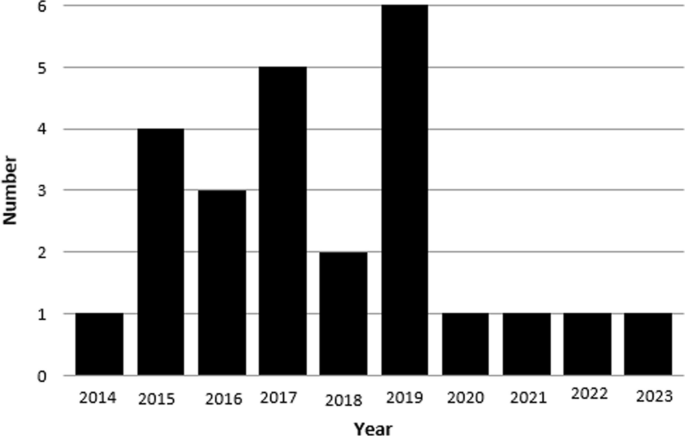
Industry base. The results of industries that utilize ICT are depicted in Fig. 5. Industries are primarily categorized into four sectors: agriculture, mining, manufacturing (including electrical industry, electronics, apparel, food, drinks, etc.), and services (such as marketing and software-based small and medium enterprises). Several articles included small- and medium-sized enterprises (SMEs) in their analysis, whereas the remaining articles did not specify the industries that were included in the study. They have been classified inside the "other" classification. Out of the chosen research, 5 studies either encompassed all small- and medium-sized enterprises (SMEs) or did not specify which SMEs were examined. The fraction of small- and medium-sized enterprises (SMEs) that implemented information and communication technology (ICT) was primarily focused on researching manufacturing. The total number of studies discovered was 11, as determined from the selected papers. Based on the graph shown (Fig. 5), it can be deduced that the adoption of ICT is more prevalent among small and medium enterprises (SMEs) in the manufacturing and services sectors, as opposed to those in the agriculture and mining sectors.
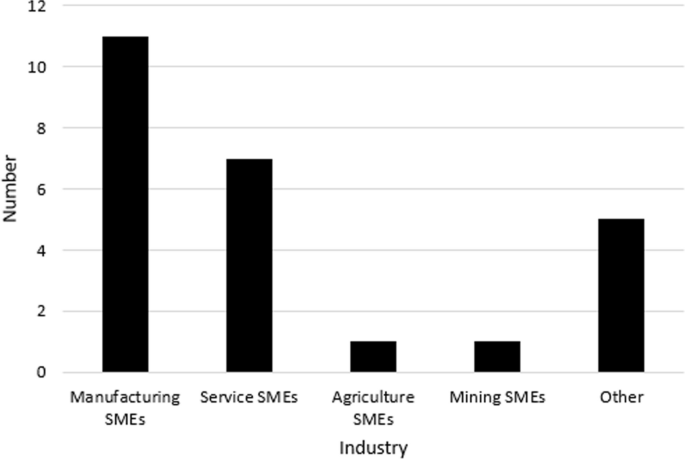
Journal base. The "International Journal of Business Information Systems" has had the highest number of publications in the past 10 years, with a total of three articles published between 2014 and 2023. Subsequently, additional magazines published a single article each. Table 2 displays the leading journals and the papers that were published during the specified time frame.
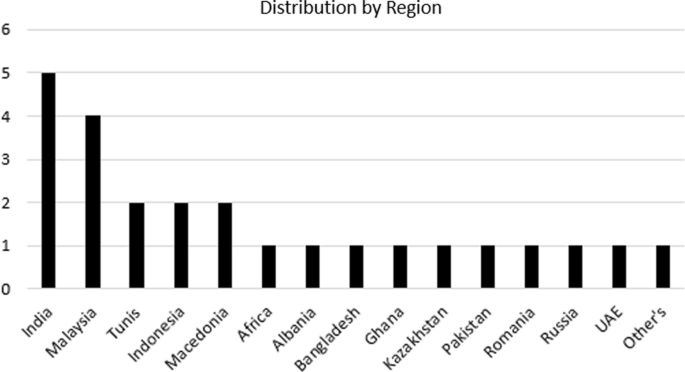
According to the citations. The minimum threshold for paper selection in this review was set at 20 citations per paper. The article authored by Puthusserry et al. (2020) received the highest number of citations among the articles in the selected column, with a total of 53 citations. Table 3 presents a concise overview of the 10 papers that have received the highest number of citations, including information about the authors and the year in which they were published.
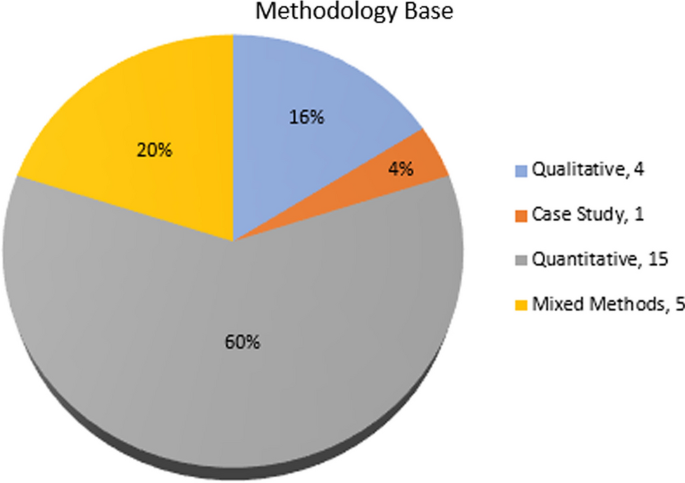
Topic 2: Influence of internal and external factors on the use of information and communication technology in small- and medium-sized businesses. The internal factors that influence the adoption and effective use of ICT by SMEs are crucial, as they have a direct impact on the performance, competitiveness, and innovation capabilities of SMEs (Rozak et al., 2023). ICT adoption enables small- and medium-sized enterprises (SMEs) to enhance their competitiveness on a global level by improving efficiency and fostering stronger ties with customers and suppliers (Vidhyalakshmi & Kumar, 2016).
The adoption of information and communication technology (ICT) in small- and medium-sized enterprises (SMEs) to enhance their competitiveness is greatly influenced by the managerial qualities of both the firms and the managers. Managers who have a forward-looking approach and are receptive to technological advances are more likely to realize the value of ICT investments in streamlining operations, increasing productivity, and opening up new market opportunities (Kossaï & Piget, 2014). The owner's receptiveness to technology and the firm's preparedness to innovate determine its willingness to implement ICT. At the same time, the costs associated with installation and implementation are essential barriers that depend on the financial health and operating budget of the SME. In addition, the anticipated return on investment from ICT deployment is also essential, as SMEs need to ensure that the financial benefits justify the initial and ongoing investment (Vidhyalakshmi & Kumar, 2016).
Kumar et al. (2017) contend that the support and commitment of senior management are crucial for the successful implementation and integration of information and communication technology (ICT) in organizational operations. Their leadership is vital in overcoming resistance to change, ensuring that the potential of ICT is fully utilized to achieve business objectives and drive growth, thus positioning SMEs to gain a competitive advantage in an increasingly digital business environment.
Results Gono et al. (2016) support the notion that the size and age of a company, along with its experience in using information and communication technology (ICT), have a significant impact on the adoption of ICT to enhance the competitiveness of small- and medium-sized enterprises (SMEs). Firm age indicates stability, which is associated with market knowledge and resource advantages, thus facilitating ICT adoption. Large firms with more employees and multiple branches tend to have better financial and human resources, enabling them to invest in and implement ICT solutions more effectively. This organizational capacity not only facilitates technology but also positions SMEs to make better use of ICT. (Ibrahim et al., 2018).
The implementation of organizational strategies, such as the formation of diverse partnerships, plays a vital role in leveraging ICT to improve SME competitiveness. Such strategies enable SMEs to access a broader range of resources, knowledge and technology (Golonka, 2015). Research Rozak et al. (2023) stated that the enhancement of digital skills among SME members, including staff, managers, leaders, and owners, significantly improved their experience with ICT, fostering a commitment to its increased use for continuous improvement, which is critical to improving the competitiveness of SMEs.
Based on the research findings of Molodchik and Jardon (2017), SMEs that invest in research and development (R&D) are better positioned to utilize ICT to improve their competitiveness. The application of cloud computing in research (Soon et al., 2015) allows SMEs to focus on their core competencies by leveraging shared services, thus eliminating traditional resource limitations and underutilized data center issues. This shift optimizes the use of technology and simplifies business processes. The efficiencies gained through these technology linkages are critical for SMEs to maintain sustainability and competitiveness in an increasingly digitized and globalized business environment.
Valaei et al. (2017) asserted that exploratory learning strategies lay the foundation for improvisational and compositional creativity, enabling organizations to strategize and react dynamically to unpredictable market changes through insights, rapid experimentation, and evolutionary learning. This approach not only fosters an innovative culture but also ensures that SMEs can utilize ICT effectively to maintain a competitive advantage in a highly competitive market.
Zaidan (2017) highlighted the need for SMEs to improve human resource competencies by hiring and rewarding skilled and talented staff, thereby creating a pleasant workplace. This strategy maintains crucial human capital and fosters the adoption and innovative exploitation of information and communication technology. Moreover, as stated by Ben Arfi and Hikkerova (2021), it is crucial to prioritize the establishment of a culture that promotes innovation and the sharing of knowledge. The combination of knowledge exchange and a culture that fosters innovation allows small- and medium-sized enterprises (SMEs) to effectively leverage information and communication technology (ICT), resulting in enhanced competitiveness within their specific markets.
External factors impact the implementation of information and communication technology (ICT) in small- and medium-sized businesses. Due to global challenges arising from technological breakthroughs and globalisation, SMEs are compelled to incorporate information and communication technology (ICT) into their operations. In addition, suppliers and consumers frequently demand online communication and transactions from SMEs (Azam, 2015). This competitive pressure, according to Mirkovski et al. (2016), requires SMEs to implement and utilize ICT as a strategic response to the competitive dynamics in their industry. The application of ICT enables SMEs to improve their operational efficiency and compete more effectively in the digital marketplace.
Research Soon et al. (2015) showed that economic turmoil and the evolution of digital markets present challenges and opportunities for SMEs in implementing ICT. In periods of economic recession, small- and medium-sized firms (SMEs) may be more careful when choosing information and communication technology (ICT) infrastructure, such as cloud computing services. Although SMEs face several obstacles, the internet's rapid expansion and the rise of cloud services offer them the chance to leverage shared services and concentrate on their core strengths. This, in turn, enhances their competitiveness in the digital market.
Amoako et al. (2022) suggested that SMEs utilize ICT tools such as electronic data interchange, the Internet, and supplier quality management software to improve operations between external partners (customers and suppliers) to achieve cooperation among supply chain partners, which in turn has a positive impact on performance. Small- and medium-sized enterprises (SMEs) have the opportunity to engage in partnerships with industry associations to implement information and communication technology (ICT). This collaboration enables SMEs to effectively and promptly respond to market dynamics and meet the evolving demands of customers. Industry organizations provide small and emerging businesses with a platform to receive assistance and knowledge through workshops. The workshops encompass a broad spectrum of subjects, including introducing novel technology and products and providing market-specific knowledge. Industry associations also offer informal mentoring opportunities where senior professionals share their experiences, successes and failures (Puthusserry et al., 2020).
Technology collaboration and innovation strategies also play an essential role in improving the competitiveness of SMEs through the application of ICT (Aslesen & Harirchi, 2015). This strategy involves SMEs engaging in partnerships and networks with external entities, such as other companies, universities, research institutes, non-governmental organizations, and government agencies, to access diverse sources of knowledge and innovative technologies (Aryanto et al., 2018).
According to JosephNg (2019), ICT consulting services are crucial for the successful implementation and maintenance of ICT solutions. External consultancy can assist small- and medium-sized firms (SMEs) in effectively managing the complexity of ICT deployment. This ensures that their technology infrastructure is not only current but also in line with their business goals, enabling them to grow and compete effectively in the market. In line with this opinion, Sivathanu (2019) also mentioned that support from technology vendors is critical. This support can range from providing ICT solutions tailored to the specific needs of SMEs to offering training and maintenance services to ensure effective implementation and use of technology.
A crucial factor, according to Heim et al. (2019), is the presence of a clear legal and regulatory framework that can address intellectual property rights, data protection, and online transactions, ensure fair competition, and facilitate access to digital infrastructure and services. Pathan et al. (2017); Dincă et al. (2019) also agree that government or regulatory support has a positive impact on ICT adoption among SMEs. Especially in developing countries, where external environmental factors and government support play an essential role in shaping the rules of ICT implementation for SMEs operating in the region (Mirkovski et al., 2019).
Topic 3: Outcomes of ICT implementation. While ICT implementation is seen as an essential factor for improving the competitiveness and operational efficiency of SMEs, its actual contribution to enterprise performance depends on how well the technology is integrated and leveraged in organizational processes. For SMEs to truly benefit from ICT, there needs to be a focus not only on ICT deployment but also on the strategic alignment of ICT with SME business processes and objectives (Azam, 2015).
ICT adoption in manufacturing SMEs improves operational efficiency and expansion into new markets through strategic partnerships with large firms (Gono et al., 2016). The utilization of ICT enables SMEs to achieve significant cost savings, maintain and enhance collaboration with business partners, manage external communication with stakeholders more effectively, and streamline transactions (Rozak et al., 2023).
ICT, especially cloud computing, provides significant benefits to SMEs by offering cost-effective ICT services that are highly favorable to new entrepreneurs. (Pathan et al., 2017). The application of ICT to SMEs, particularly in the agricultural sector, has been shown to significantly increase their productivity and contribute to a country's Gross Domestic Product (Ibrahim et al., 2018).
SMEs categorized as using ICT moderately or intensively show a net profit margin of more than 2% compared to companies that do not use ICT (Kossaï & Piget, 2014). In line with that, Vidhyalakshmi and Kumar (2016) also concluded that the application of ICT in SMEs has shown significant positive results, including increased global market presence, increased agility, and increased profitability.
Topic 4. Barriers to ICT adoption. SMEs in developing countries that are already large, with many branches and employees, are successfully applying ICT to improve their competitiveness by increasing sales and marketing, streamlining operations, efficiently managing remote branches and engaging in strategic collaboration. Nevertheless, this is a significant difficulty for small-scale SMEs, particularly those in their nascent stages, since they encounter numerous constraints when it comes to utilizing their resources. Researchers have found several significant obstacles to the use of ICT in SMEs, which are outlined in Table 4.
Table 4 Barriers to ICT adoptionThe primary obstacles to the adoption of ICT are budgetary limitations, deficiencies in skills, inadequate utilization of ICT, characteristics of the organization and its owner, government assistance, and insufficient awareness and trust. Small- and medium-sized enterprises (SMEs) must comprehend these obstacles to devise effective ways to overcome them when employing ICT (Kossaï & Piget, 2014).
The need for more skilled personnel to implement and manage ICT solutions is a significant obstacle for SMEs in developing countries. SMEs often need more financial resources compared to large enterprises, making it difficult to invest in ICT (Vidhyalakshmi & Kumar, 2016).
The characteristics and attitudes of firms and their owners towards technology adoption can significantly influence the extent of ICT implementation. SMEs led by owners who do not prioritize ICT tend to underutilize ICT (Kossaï & Piget, 2014).
SMEs need to fully realize the benefits and potential of ICT in improving their business operations and competitiveness. In addition, concerns over security and privacy lead to a need for more trust in ICT solutions. Sivathanu (2019) suggested that the government should help in terms of incentives, subsidies, and policies that encourage ICT adoption, as a lack of government support can be a significant obstacle to ICT adoption by SMEs.
This study's main objective is to thoroughly assess the current body of literature on information and communication technology (ICT) and offer responses to the research questions. This study focuses on the first research topic by providing a concise overview of the current research on the pivotal role of Information and Communication Technologies (ICTs) in improving the competitiveness of small and medium companies (SMEs) in developing economies. This is accomplished by employing descriptive statistics. The current material was classified into four main categories to address the second research question. The study has collated the 25 most cited publications on Information and Communication Technology (ICT) in small and medium companies (SMEs) in developing countries published during the last decade. The researchers have compiled and condensed the essential findings they have produced. Overall, there is a need to enhance the amount of ICT research conducted on small and medium enterprises (SMEs) in developing nations that obtain more than 20 citations.
According to the descriptive statistics, India represents 20% of the highly referenced ICT research on small and medium enterprises (SMEs) in developing countries. While scholars from other developing countries also made contributions, it was primarily Indian researchers who played a prominent role, highlighting a noticeable disparity in ICT studies in other developing nations. Since ICT research is primarily conducted in established SMEs, future studies must investigate using various ICT tools and platforms to enhance diverse aspects of SME performance in developing nations. This study should also focus on identifying the obstacles that arise and finding strategies to overcome them.
The current research on information and communication technology (ICT) in small- and medium-sized firms (SMEs) primarily focuses on SMEs in the manufacturing and services sectors. Other related industries have gotten less attention in these studies. Moreover, a cross-sectional design is predominantly employed in most research studies. Future longitudinal research has the potential to offer fresh insights into the unresolved process. Implementing policies for ICT operations in small- and medium-sized firms (SMEs), especially in developing nations, is of utmost importance. Investigations should highlight the impact of government intervention in promoting the adoption of information and communication technology (ICT) to strengthen the competitiveness of small- and medium-sized firms (SMEs). The study has identified intrinsic and extrinsic factors that need to be addressed to promote the implementation of Information and Communication Technology (ICT) in Small and Medium Enterprises (SMEs) in developing countries. The fourth study examines the limitations and outcomes of introducing information and communication technology (ICT) in small and medium enterprises (SMEs) in developing nations.
The data sets used and described during this study are available from the corresponding author.
We want to acknowledge and thank the (1) Center for Higher Education Funding (Balai Pembiayaan Pendidikan Tinggi—BPPT), Ministry of Education, Culture, Research, and Technology Republic of Indonesia, and (2) Indonesia Endowment Fund for Education (Lembaga Pengelola Dana Pendidikan—LPDP), Ministry of Finance Republic of Indonesia for granting a scholarship to the first author to complete his studies (Registration Number: B3172023011028195727 and BPI Number: 202329113409). In addition, we would like to thank Huma Sikandar for sharing his research article on systematic literature insights.
This research was funded by The Center for Higher Education Funding (Balai Pembiayaan Pendidikan Tinggi—BPPT), Ministry of Education, Culture, Research, and Technology, Republic of Indonesia, and the Indonesia Endowment Funds for Education (Lembaga Pengelola Dana Pendidikan—LPDP), Ministry of Finance, Republic of Indonesia.